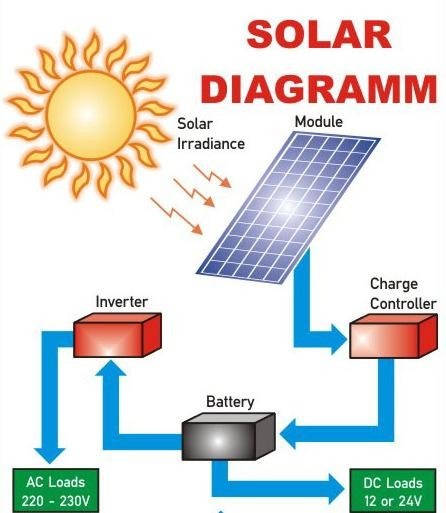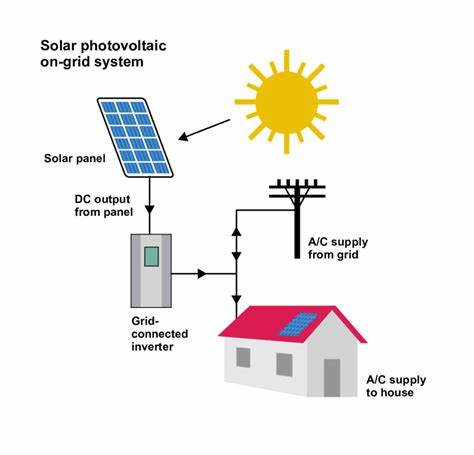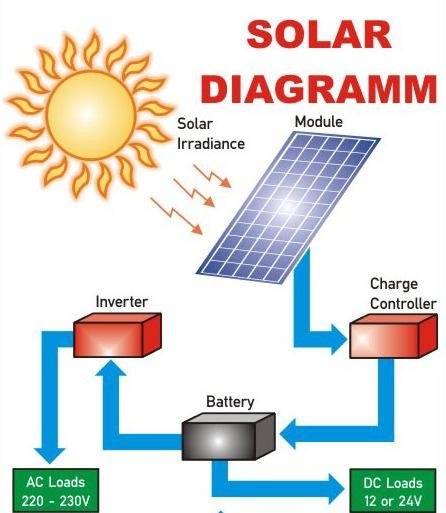Solar Home System
| Site: | Protech Engineering |
| Course: | Protech Engineering |
| Book: | Solar Home System |
| Printed by: | |
| Date: | Saturday, 26 April 2025, 1:09 PM |
Description
How to design a solar home system
1. DIY SOLAR HOME SYSTEM
Welcome to this 5 days course that will equip you on the know-how and practical solar home system sizing and installation for your home.
Step 1:
Key Learning Outcomes:
By the end of this course, learners will be able to:
-
Understand the fundamentals of solar energy and its applications in home systems.
-
Explain the components of a solar home system (panels, batteries, charge controllers, inverters, etc.).
-
Design a basic solar home system based on household energy needs.
-
Calculate energy requirements, system sizing, and cost estimation.
-
Install and maintain a small-scale solar home system (theoretical/practical guidance).
-
Evaluate the economic and environmental benefits of solar home systems.
Essential Questions to Guide Learning:
-
How does solar energy work, and why is it important for homes?
-
What are the key components of a solar home system, and how do they function together?
-
How do you size a solar home system for different energy needs?
-
What are the best practices for installation and maintenance?
-
How cost-effective and sustainable are solar home systems compared to grid electricity?
Step 2:
Assessment Methods:
-
Quizzes & Knowledge Checks (Formative Assessment)
-
MCQ quizzes on solar energy basics, components, and system design principles.
-
Short-answer questions on calculations (e.g., load assessment, battery sizing).
-
-
Case Study Analysis
-
Learners analyze a household’s energy consumption and propose a solar solution.
-
-
Design Project (Summative Assessment)
-
Learners create a Solar Home System Design Plan for a given scenario, including:
-
Energy demand calculation
-
Component selection (panel wattage, battery capacity, etc.)
-
Cost estimation
-
Sustainability benefits
-
-
-
Peer Review & Discussion
-
Learners share their designs and critique each other’s work.
-
-
Final Exam (Optional)
-
Comprehensive test covering theory, calculations, and troubleshooting.
-
Step 3:
Course Structure:
Module 1: Introduction to Solar Home Systems
-
Topics: Solar energy basics, benefits of SHS, types of systems (on-grid/off-grid).
-
Activities: Video lecture, infographics, discussion forum ("Share your experience with solar energy").
Module 2: Components of a Solar Home System
-
Topics: Solar panels, batteries, charge controllers, inverters, wiring.
-
Activities:
-
Interactive diagram labeling exercise.
-
Virtual lab simulation (e.g., testing different component setups).
-
Module 3: System Sizing & Design
-
Topics: Load assessment, solar irradiance, battery bank sizing, cost estimation.
-
Activities:
-
Step-by-step calculation exercises (Excel/Google Sheets tool provided).
-
Case study: "Design a system for a rural home with X kWh/day usage."
-
Module 4: Installation & Maintenance
-
Topics: Safety precautions, mounting panels, wiring, troubleshooting.
-
Activities:
-
Video demonstration of installation.
-
Simulated fault-finding exercise (e.g., "Why is the battery not charging?").
-
Module 5: Economics & Sustainability
-
Topics: Payback period, subsidies, environmental impact.
-
Activities:
-
Debate: "Is solar worth the initial cost?"
-
ROI calculation assignment.
-
Bonus: A certificate upon completion to motivate learners.
1.1. MODULE 1
Module 1: Introduction to Solar Home Systems
1. Solar Energy Basics
Key Notes:
-
Solar energy comes from the sun → converted to electricity via photovoltaic (PV) panels.
-
How it works:
-
Sunlight hits solar panels → generates DC electricity.
-
Inverter converts DC → AC (used in homes).
-
Excess power can be stored in batteries or fed back to the grid.
-

2. Benefits of Solar Home Systems (SHS)
Key Notes:
✔ Cost-saving – Reduces electricity bills.
✔ Reliable – Works in off-grid areas.
✔ Eco-friendly – No pollution, reduces carbon footprint.
✔ Low maintenance – Few moving parts, long lifespan (20-25 years).
"Why Go Solar?"
-
💰 Save Money
-
🌍 Clean Energy
-
⚡ Energy Independence
3. Types of Solar Home Systems
| System Type | Best For | Pros | Cons |
|---|---|---|---|
| On-Grid | Homes with grid access | - Lower cost (no batteries) - Sell excess power |
- No power during grid outages |
| Off-Grid | Remote areas, no grid | - Works 24/7 with batteries - Full independence |
- Expensive (batteries needed) |
| Hybrid | Best of both worlds | - Uses grid + batteries - Backup power |
- Higher upfront cost |
"Which Solar System Fits You?"
-
On-Grid → [House + Grid Lines]

-
Off-Grid → [House + Battery + Solar Panel]

-
Hybrid → [House + Grid + Battery]

-
-
-
Discussion Forum Prompt:
-
"Have you or someone you know used solar energy? Share your thoughts!"
-
Bonus: Quick Quiz
-
What converts sunlight into electricity?
-
(a) Inverter
-
(b) Solar Panel
-
(c) Battery
-
-
Which system needs batteries to work?
-
(a) On-Grid
-
(b) Off-Grid
-
(c) Hybrid
-
1.2. MODULE 2
Module 2: Components of a Solar Home System
1. Solar Panels (PV Modules)
-
Function: Convert sunlight → DC electricity.
-
Types:
-
Monocrystalline (High efficiency, expensive).
-
Polycrystalline (Mid efficiency, affordable).
-
Thin-film (Lightweight, flexible, lower efficiency).
-
-
Key Term: Wattage (W) = Power output (e.g., 300W panel).
2. Batteries (Energy Storage)
Key Notes:
-
Function: Store extra power for use at night/cloudy days.
-
Types:
-
Lead-Acid (Cheap, heavy, shorter lifespan).
-
Lithium-ion (Light, long lifespan, expensive).
-
-
Key Term: Capacity (Ah/kWh) = How much energy is stored.
3. Charge Controller (Battery Protector)
Key Notes:
-
Function: Regulates power from panels to the batteries (prevents overcharging).
-
Types:
-
PWM (Basic, cheaper).
-
MPPT (More efficient, costly, best for large systems).
-
4. Inverter (DC → AC Converter)
Key Notes:
-
Function: Converts DC (from panels/batteries) to AC (for home appliances).
-
Types:
-
Pure Sine Wave (Best for sensitive electronics).
-
Modified Sine Wave (Cheaper, may harm some devices).
-
"Inverter Types"
🔌 Pure Sine Wave → Laptops, TVs, medical devices
🔌 Modified Sine Wave → Lights, fans, basic tools
5. Wiring & Safety Gear
Key Notes:
-
Cables: Thick, UV-resistant (for outdoor use).
-
Fuses/Disconnects: Prevent fires from overloads.
-
Mounting Structure: Rust-proof frames for panels.
"Safety First!"
⚡ Use DC-rated switches
🔥 Install fuses near batteries
☀️ Secure panels with strong racks
-
Discussion Prompt:
-
"Would you choose lithium or lead-acid batteries? Why?"
-
Quick Quiz
-
Which charge controller is more efficient for large systems?
-
(a) PWM
-
(b) MPPT
-
-
True or False: Modified sine wave inverters are safe for laptops.
-
False
- True
-
Bonus: Component Cheat Sheet (PDF)
| Component | Purpose | Key Specs |
|---|---|---|
| Solar Panel | Sun → DC power | Wattage (e.g., 300W) |
| Battery | Stores energy | Capacity (e.g., 100Ah) |
| Inverter | DC → AC for homes | Sine wave type |
1.3. MODULE 3
Module 3:
Solar Home System Sizing & Design
Key Concepts
1. Load Assessment (How Much Power Do You Need?)
Step 1: List all appliances + their power (Watts) and usage time (Hours).
Step 2: Calculate Daily Energy (Watt-hours, Wh) = Power (W) × Hours used.
📌 Example:
| Appliance | Power (W) | Hours Used | Daily Energy (Wh) |
|---|---|---|---|
| LED Bulb | 10W | 5 hours | 10 × 5 = 50Wh |
| Fan | 50W | 8 hours | 50 × 8 = 400Wh |
| Total | 450Wh/day |
2. Solar Irradiance (How Much Sun Do You Get?)
-
Measured in peak sun hours (average sunlight intensity per day).
-
Example: If your location gets 5 peak sun hours, a 100W panel produces:
-
100W × 5h = 500Wh/day.
-
🌍 Check Your Sun Hours:
-
Use Global Solar Atlas or PVWatts.
3. Solar Panel Sizing
Formula:
Total Daily Energy (Wh) ÷ Peak Sun Hours = Panel Size (W)
📌 Example:
-
Need 450Wh/day ÷ 5 sun hours = 90W panel (round up to 100W).
4. Battery Bank Sizing
Step 1: Decide Days of Autonomy (backup days, e.g., 2 days).
Step 2: Factor in Depth of Discharge (DoD) (e.g., 50% for lead-acid).
Formula:
(Total Daily Energy × Backup Days) ÷ DoD = Battery Size (Wh)
📌 Example:
-
450Wh/day × 2 days = 900Wh
-
900Wh ÷ 50% DoD = 1,800Wh (or 1.8kWh) battery needed.
-
If using 12V batteries: 1,800Wh ÷ 12V = 150Ah battery.
5. Cost Estimation
| Component | Example Specs | Estimated Cost |
|---|---|---|
| 100W Solar Panel | Monocrystalline | 1,000 |
| 150Ah Battery | Lead-Acid Deep Cycle | 10,000 |
| 20A Charge Controller | PWM | 3,500 |
| 300W Inverter | Pure Sine Wave | 5,000 |
| Total | 19,500 |
Activity 3: Step-by-Step Calculation (Excel/Google Sheets Tool)
📊 Downloadable Tool Includes:
-
Load Calculator (Enter appliances → auto-sums energy needs).
-
Solar Panel & Battery Sizing (Input sun hours → suggests system size).
-
Cost Estimator (Compares budget vs. premium components).
Activity 4:
Case Study – Design a Rural Home System
-
A family in Khakhameka uses:
-
3 LED bulbs (10W, 4 hours/day).
-
1 Fan (50W, 6 hours/day).
-
1 Phone Charger (5W, 2 hours/day).
-
-
Peak Sun Hours: 4.5.
-
Backup Needed: 2 days.
Task:
-
Calculate daily energy needs. (Answer: 290Wh/day)
-
Size the solar panel. (Answer: 65W → round to 100W)
-
Size the battery (50% DoD). (Answer: 1,160Wh → 12V/100Ah battery)
-
Estimate cost.
Cheat Sheet: Solar Sizing Formulas
-
Daily Energy (Wh) = Power (W) × Hours Used
-
Panel Size (W) = Daily Energy ÷ Peak Sun Hours
-
Battery (Wh) = (Daily Energy × Backup Days) ÷ DoD
Common Mistakes to Avoid
❌ Forgetting inverter losses (add 20% extra panel power).
❌ Ignoring battery DoD (e.g., using 100% of lead-acid kills it fast!).
❌ Underestimating cloudy days (always add backup days).
Watch theStep by step video tutorial
1.4. MODULE 4
Module 4:
Solar Home System Installation & Maintenance
1. Safety Precautions
⚠️ Work Safely!
-
Turn off all power (solar panels + batteries) before wiring.
-
Wear gloves & goggles (battery acid is dangerous!).
-
Use insulated tools to avoid shocks.
-
Never touch bare wires or live terminals.
📌 Remember:
-
Solar panels generate power even when it’s cloudy!
-
Batteries can explode if short-circuited.
2. Mounting Solar Panels
Where to Install?
-
Best Spot: Rooftop or ground with no shade (south-facing in the Northern Hemisphere).
-
Angle: Tilt panels to match your latitude for max sunlight.
How to Mount?
-
Fix mounting brackets (roof/ground).
-
Attach panels securely (use rust-proof bolts).
-
Leave gaps for airflow (prevents overheating).
📌 Pro Tip:
-
Check for strong winds/snow load in your area!
3. Wiring the System
Step-by-Step:
-
Connect panels → charge controller (use thick, UV-resistant cables).
-
Connect charge controller → battery (match + and – terminals!).
-
Connect battery → inverter → home appliances.
📌 Key Rules:
-
Fuse all connections (prevents fires).
-
Keep wires short & tidy (less power loss).
4. Troubleshooting Common Issues
Problem 1: Battery Not Charging
✅ Check:
-
Are panels in sunlight?
-
Are all wires connected tightly?
-
Is the charge controller working (LED lights on)?
Problem 2: Inverter Not Powering Appliances
✅ Check:
-
Is the battery charged?
-
Is the inverter turned on?
-
Is the inverter big enough for the appliance?
Problem 3: Low Power Output
✅ Check:
-
Are panels dirty? (Clean with water + soft cloth.)
-
Is there shading on panels?
Activities
1. Video Demonstration
📹 Watch a step-by-step installation (10 mins):
-
Mounting panels → Wiring → Testing the system.
2. Fault-Finding Exercise
🔧 Scenario: "The battery isn’t charging. What’s wrong?"
-
Learners check:
-
Loose wires?
-
Blown fuse?
-
Dead charge controller?
-
Quick Cheat Sheet
| Issue | Likely Fix |
|---|---|
| No power to inverter | Check battery charge & fuses |
| Panels not working | Clean panels, check connections |
| Battery drains fast | Add more panels/batteries |
1.5. MODULE 5
Module 5:
Solar Economics & Sustainability
1. Payback Period
What? Time needed to recover your solar investment through savings.
Formula:
Total System Cost ÷ Annual Savings = Payback Period (Years)
Example:
-
System cost: 19,500
-
Saves 2,400/year on electricity bills
-
Payback =
19,500÷2,400 = 8 years
📌 Note: Shorter payback = Better investment!
2. Environmental Impact
✅ Benefits:
-
Zero pollution (No CO₂ emissions).
-
Reduces fossil fuel use (Coal, diesel generators).
-
Sustainable (Sunlight is unlimited!).
📌 Fun Fact:
A 5kW solar system cuts ~5 tons of CO₂ yearly = Planting 100 trees!
Takeaway
✔ Solar pays back in 3-7 years (then FREE power!).
✔ 1 solar home = 1 less diesel generator polluting the air!